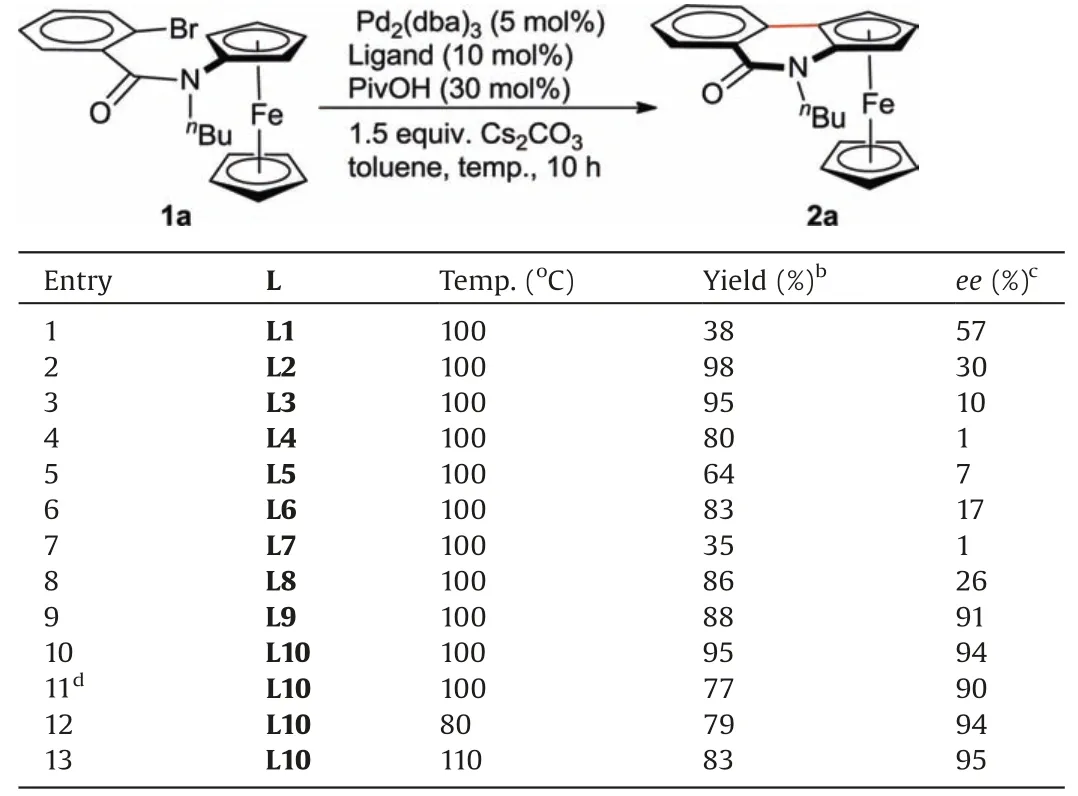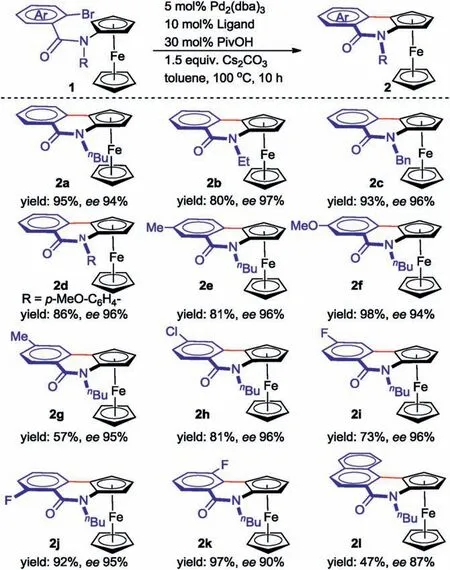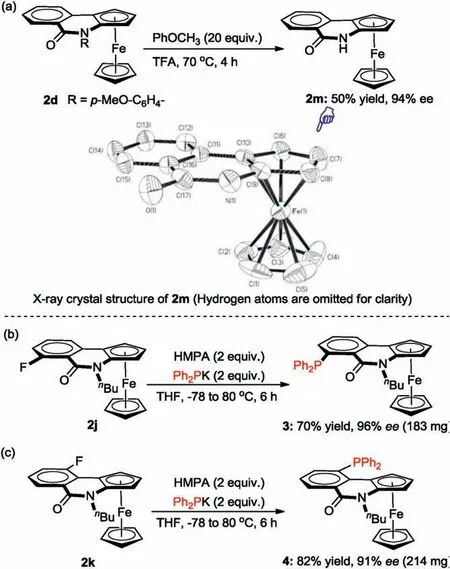Synthesis of planar chiral isoquinolinone-fused ferrocenes through palladium-catalyzed C-H functionalization reaction
2021-04-02LntoLiuHuihuiLiuZhenzhenZuoAnAnZhngZhongyiLiTunjieMengWeiWuYunzhoHuGuolingMo
Lnto Liu*,Huihui Liu,Zhenzhen Zuo,An-An Zhng,Zhongyi Li,Tunjie Meng,Wei Wu,Yunzho Hu,Guoling Mo,*
aHenan Engineering Laboratory of Green Synthesis for Pharmaceuticals, College of Chemistry and Chemical Engineering, Shangqiu Normal University,Shangqiu 476000, China
b College of Chemistry and Chemical Engineering, Northeast Petroleum University, Daqing 163318, China
c Beijing National Laboratory for Molecular Sciences (BNLMS), College of Chemistry, Peking University, Beijing 100871, China
d College of Chemistry, Zhengzhou University, Zhengzhou 450001, China
ABSTRACT(S,S)-Me-BI-DIME/Pd(0)-catalyzed ennantioselective C-H functionalization of N-ferrocenyl o-bromobenzanilides has been realized, affording isoquinolinone-fused ferrocenes with up to 97% ee.The products can be transformed into planar chiral ferrocenyl monophosphines, which demonstrate their preliminary application.
Keywords:(S,S)-Me-BI-DIME Palladium Asymmetric catalysis C-H functionalization Planar chiral ferrocenes
Compounds containi ng a phenanthridinone skeleton possess remarkable biological and pharmaceutical properties, such as antilymphoma,antileukemia,antitumor,antiviral and inhibitor of HIV-1 integrase, etc.[1].Replacement of aryl rings by ferrocenyl moieties usually improves the properties of a given biomolecule dramatically [2].Hence, the synthesis of planar-chiral isoquinolinone-fused ferrocenes, phenanthridinone analogues, are worth expecting for biochemists and pharmaceutical chemists.
On the otherhand,planarchiralferroceneshave beenextensively utilized as privileged chiral catalyst and ligands in asymmetric catalysis(Fig.1)[3].Therefore,intensiveeffortshavebeendevotedto their asymmetric synthesis, and significant progress has been achieved using transition-metal-catalysts[4].Recently,asymmetric C-H bond functionalization [5] enables the concise synthesis of planar chiral ferrocenes[6-18].The Binap/Pd catalyzed intramolecular cyclization of ferrocenyl(o-bromo)aryl ketones,independently developed by You group and Gu et al.,enabled the elegant synthesis of planar chiral ferrocenes(Scheme 1a)[8a,8b].Then,the synthesis of planar chiral quinilinoferrocenes, with moderate enantioselectivity in some cases,was realized with(R,Sa)-O-PINAP as the ligand[8c].Soon after that,our group reported the asymmetric synthesis of these scaffolds in excellent enantioselectivity with TADDOLderived phosphoramidite as ligand[8d].Stereospecific synthesis of them could also be realized via a metallocenic radical pathway[8j].Planar-chiral lactam-fused ferrocenes, can serve as precursors of useful planar-chiral pyridines.The planar-chiral lactam-fused ferrocenes with the nitrogen atom directly linked with ferrocenyl ring, are more attractive [16,17].Very recently, a wonderful asymmetric oxidative annulationof twofold C-Hbonds and alkynes wasrealizedbyusingchiralNi-Albimetalliccatalyst,providingsuch kind of planar-chiral lactam-fused ferrocenes in excellent ee values(Scheme 1b)[18].Despite the significant achievement,the efficient asymmetric synthesis of the planar-chiral lactam-fused ferrocenes in a catalytic manner is still highly desirable.Inspired by the previousworksonPd(0)-catalyzedenantioselective C-H activation,we report herein the synthesis of planar-chiral isoquinolinonefusedferrocenesvia Pd(0)-catalyzedC-Hfunctionalizationreaction(Scheme 1c).(S,S)-Me-BI-DIME,P-chiral monophosphorus ligands developed by Tang group[19],proved to be critical,delivering the desired products with up 97%ee.

Fig.1.Excellent catalyst and chiral ligands based on planar-chiral ferrocenes.

Scheme 1.Synthesis of planar chiral ferrocenes via C-H functionalization.
Readily available N-ferrocenyl o-bromobenzanilides 1a was selected as model substrate for the optimization of reaction conditions (Table 1).However, it is very difficult to control the enantioselectivity.The catalytic systems, used in the above mentioned reactions, are not suitable for this reaction [8].For example,the combination of TADDOL-derived phosphoramidite L1 with Pd2(dba)3which gave excellent enantioselectivity in the synthesis of planar chiral quinilinoferrocenes [8d], afforded 2a in just 38% yield with 57% ee (Table 1, entry 1) [20].Although excellent yields were obtained by using L2 and L3, the ee values were even poorer(Table 1,entries 2 and 3).Both H8-BINOL-derived phosphoramidite L4 and BINOL-derived phosphoramidite L5 showed very poor enantioselectivities (Table 1, entries 4 and 5).The P-chiral birayl monophosphorus ligands developed by Tang group were then evaluated in the reaction (Table 1, entries 6-13).Ligands L6-L8 containing one P-chiral centre gave desired product in very poor ee (Table 1, entries 6-8).Pleasingly, both L9 and L10,with an additional chiral center,gave 2a in good to excellent yields(95%)and with excellent enantioselectivities(94%)(Table 1,entries 9 and 10).The addition of PivOH improved yield and enantioselectivity of the reaction(Table 1,entry 10 vs.11).Although lower or higher temperature led to lower yields,the enantioselectivity was still excellent (Table 1, entries 12 and 13).
Under the optimized reaction conditions, the scope of Nferrocenyl o-bromobenzanilides 1 was investigated and the result is listed in Scheme 2.The substrates, 1a-1d, with different Nprotecting groups such as Et-, Bn-,nBu-and p-MeO-C6H4-groups reacted smoothly to furnish the desired products,2a-2d,in good to excellent yields and with excellent enantioselectivity (94%-97%ee).The substrates, with substituents at the 5-position of the phenyl rings,yielded products 2e and 2f in good to excellent yields with excellent enantioselectivity (96% and 94% ee).Although substrate 1g, with a methyl group at the 4-position of the phenyl rings, led to moderate yield, the substrates with the Cl-and Fsubstituents on the same positions,afforded products 2h and 2i ingood isolated yields with excellent enantioselectivity.Regardless of their steric effect,the substrates with the F-substituents reacted smoothly to give products 2i-2k in excellent ee value(90%-96%ee).Product 2l,with polycyclic rings,could also be obtained in good ee.

Table 1 Optimization of reaction conditions for asymmetric transformation.a

Scheme 2.The scope of substrates.Reaction conditions:amide 1a(0.10 mmol,1.0 equiv.), Pd2(dba)3 (5 mol%), L (10 mol%), Cs2CO3 (0.15 mmol, 1.5 equiv.), toluene(1 mL),under N2 for 10 h.Isolated yields determined by chiral HPLC.2j and 2k are in 0.20 mmol scale.

Scheme 3.Deprotection of 2d (a), and synthesis of planar ferrocene-based phosphines 3 (b), as well as 4 (c).
The preliminary synthetic utilization of the products were carried out,and the result was listed in Scheme 3.Treatment with 20 equiv.of PhOCH3in TFA at 70°C for 4 h,2d was transformed to 2m, a useful synthetic building block, in 50% isolated yield with 94%ee(Scheme 3a).The absolute configuration of 2m was assigned as Spby X-ray crystallographic analysis (CCDC: 2024984).Planar chiral phosphines have proved to be privileged ligands in transition-metal catalysed asymmetric catalysis,and for example,(R,Sp)-xyliphos shown in Fig.1 have been successfully utilized in industrial chemistry for the manufacture of (S)-metolachlor.Therefor it is highly desirable to transform the products to useful planar chiral phosphines.To our delight, 2j and 2k worked well with Ph2PK in the presence of HMPA,generating planar ferrocenebased phosphines 3 and 4 in good yields without any erosion in enantioselectivity.
In conclusion,an efficient and highly enantioselective synthesis of planar chiral isoquinolinone-fused ferrocenes has been realized via palladium-catalyzed C-H functionalization reaction under mild condition.P-chiral biaryl monophosphorus ligand, (S,S)-Me-BIDIME, is crucial for the enantioselectivity.Moreover, the chiral products with F-substituent could be transformed to planar ferrocene-based phosphines in one step.Further applications of the method are currently underway in our laboratory.
Declaration of competing interest
The authors report no declarations of interest.
Acknowledgments
We are grateful for the financial support from the National Natural Science Foundation of China (Nos.21572126, 21202095,14HASTIT016), Technicians Troop Construction Projects of Henan Province(No.C20150030),and Program of Science and Technology Innovation Talents of Henan Province (No.184100510011).We would like to dedicate this work to Professor Li-Xin Dai for his 96th birthday.
杂志排行
Chinese Chemical Letters的其它文章
- Diverse synthesis of the C ring fragment of bryostatins via Zn/Cu-promoted conjugate addition of α-hydroxy iodide with enone
- Directly conversion the biomass-waste to Si/C composite anode materials for advanced lithium ion batteries
- Mechanism and selectivity of copper-catalyzed borocyanation of 1-aryl-1,3-butadienes: A computational study
- Recent advances in the improvement of g-C3N4 based photocatalytic materials
- In-situ electro-deposition synthesis of MnOx-NiCo2O4 monolithic catalyst with rich phase interfaces
- Aconapelsulfonines A and B, seco C20-diterpenoid alkaloids deriving via Criegee rearrangements of napelline skeleton from Aconitum carmichaelii
